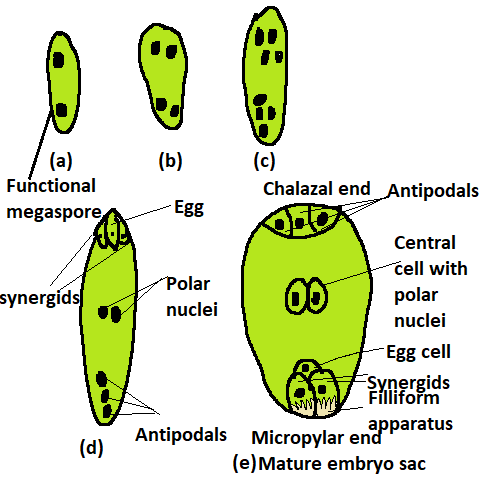Introduction
The monosporic development of the female gametophyte represents a fascinating aspect of plant reproductive biology, particularly in angiosperms. In this comprehensive exploration, we delve into the intricacies of monosporic development, shedding light on the processes, significance, and variations observed in the creation of the female gametophyte.
Step 1: Defining Monosporic Development
Definition: Monosporic development refers to the formation of the female gametophyte from a single functional megaspore within the ovule. This process is characteristic of angiosperms, the flowering plants, where the female reproductive structures undergo a specialized and sequential development to ensure successful sexual reproduction.
Step 2: Initiation of Monosporic Development
Megaspore Mother Cell: The process begins with the formation of the megaspore mother cell within the ovule. This specialized cell undergoes meiosis, resulting in the production of four haploid megaspores.
Survival of a Single Megaspore: Despite the production of four megaspores, typically only one survives and develops further. This surviving megaspore serves as the precursor for the monosporic development of the female gametophyte.
Step 3: Megaspore Maturation and Differentiation
Megaspore Maturation: The selected megaspore undergoes maturation, accompanied by changes in its structure and metabolic activities. This maturation process marks the initiation of the monosporic pathway leading to female gametophyte development.
Nuclear Division: Within the maturing megaspore, several rounds of nuclear divisions occur without cellular divisions, resulting in the formation of a multinucleate cell known as the coenocyte.
Cellular Differentiation: As the coenocyte continues to develop, cellular differentiation takes place, leading to the formation of distinct cell types within the female gametophyte. These include the egg cell, synergids, and antipodal cells, each playing a crucial role in the reproductive process.
Step 4: Formation of the Embryo Sac
Embryo Sac Formation: The fully differentiated female gametophyte is referred to as the embryo sac. This sac is a complex structure composed of cells with specialized functions, strategically positioned within the ovule to facilitate fertilization.
Polar Nuclei Fusion: One of the distinctive features of the embryo sac is the fusion of polar nuclei, a process that contributes to the formation of endosperm upon fertilization. This endosperm serves as a nutrient reservoir for the developing embryo.
Step 5: Significance and Variations
Significance in Angiosperms: Monosporic development is a hallmark of angiosperms, distinguishing them from other plant groups. This intricate process ensures the production of female gametophytes with specific cellular arrangements conducive to successful fertilization.
Variations in Monosporic Development: While monosporic development is a common feature, variations exist among angiosperms. Some species exhibit modifications in the number of surviving megaspores, nuclear divisions, or cellular differentiations, showcasing the adaptability of this reproductive strategy.
Step 6: Evolutionary Implications
Evolutionary Advantages: The monosporic development of the female gametophyte is believed to confer evolutionary advantages, enhancing the reproductive success of angiosperms. The precision in the production of female gametophytes and the specific cellular differentiations contribute to the efficiency of the fertilization process.
Adaptations and Diversification: The variations observed in monosporic development across plant species reflect adaptations to diverse ecological niches and reproductive strategies. These adaptations have played a crucial role in the evolutionary success and diversification of angiosperms.
Development of Monosporic embryo sac.
To describe the stages in embryo sac development and organization the simplest monosporic type of development is given below.
The functional megaspore is the first cell of the embryo sac or female gametophyte. The megaspore elongates along micropylar-chalazal axis. The nucleus undergoes a mitotic division. Wall formation does not follow the nuclear division. A large central vacuole now appears between the two daughter nuclei. The vacuole expands and pushes the nuclei towards the opposite poles of the embryo sac. Both the nuclei divide twice mitotically, forming four nuclei at each pole.
Conclusion
monosporic development stands as a remarkable feature in the reproductive biology of angiosperms. This intricate process, from the initiation of a single megaspore to the formation of a specialized female gametophyte, exemplifies the precision and complexity embedded in plant reproductive strategies. Understanding monosporic development not only unveils the marvels of angiosperm reproduction but also provides insights into the evolutionary adaptations that have shaped the diversity of flowering plants.

